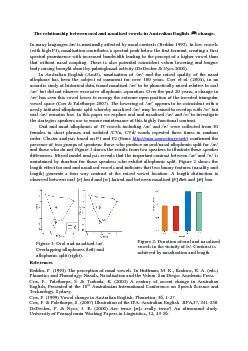/


ID: 126384
Download Pdf The PPT/PDF document "The relationship between oral and nasali..." is the property of its rightful owner. Permission is granted to download and print the materials on this web site for personal, non-commercial use only, and to display it on your personal computer provided you do not modify the materials and that you retain all copyright notices contained in the materials. By downloading content from our website, you accept the terms of this agreement.
The relationship between oral and nasalised vowels in Australian English / æ / change . In many languages / æ / is maximally affected by nasal contexts (Beddor 1993). In low vowels (with high F1), nasalisation contributes a spectral peak below the first formant, creating a first spectral prominence with increased bandwidth leading to the percept of a higher vowel than that without nasal coupling . There is also potential coincident velum lowering and tongue body raising brought about by palatoglossal activity (DeDecker & Nycs 2006). In Aus tralian English (AusE) , nasalisation of /æ/ and the raised quality of the nasal allophone has been the subject of comment for over 100 years . Cox et al . (2004) , in an acoustic s tudy of historical data , found nasalised /æ/ to be phonetically raised relative to oral /æ/ but did not observe ex cessive allophonic separation. Over the past 20 years , a change in /æ/ has seen this vowel lower to occupy the extreme open position of the inverted triangular vowel space (Cox & Palethorpe 2007). The lowering of /æ/ appears to be coincident with a newly initiated allophonic split whereby nasalised /æ/ may be raised to overlap with /e/ but oral /æ/ remains low . In this paper we explore ora l and nasalised /æ/ and /e/ to investigate the strategies speakers use to ensure maintenance of th is highly functional contrast . Oral and nasal allophones of 18 vowels including /æ/ and /e/ were collected from 30 females in short phrases and isolated /CVn, CVd / words repeated three times in random order. Cluster analysis based on F1 and F2 ( Emu: http://emu.sourceforge.net/ ) confirmed the presence of two groups of speakers: those who produce a n oral/nasal allopho nic split for /æ/ and those who do not. Figure 1 shows the results from two speakers to illustrate these speaker differences. Mixed model analysis reveals that the important contrast between /æ/ and /e/ is maintained by duration for those speakers who exhibit allo phonic split . Figure 2 shows the length effect for oral and nasalised vowels and indicates that two binary features (nasality and length) generate a four way contrast at the raised vowel location. A length distinction is observed between oral [ e ] head and [ e Ë] haired and between nasalised ] Ben and [ ] ban . Figure 1: Oral and nasalis ed / æ / . Overlapping allophones (lef t ) and allophonic split (right ). Figure 2: Duration of oral and nasalised vowels in the vicinity of /e/. Contrast is achieved by nasalisation and length References Beddor, P. (1993) The perception of nasal vowels. In Huffman, M. K., Kra kow, R. A. (eds.) Phonetics and Phonology: Nasals, Nasalisation and the Velum . San Diego: Academic Press. Cox, F., Pale thorpe, S. & Tsukada , K. ( 2004 ) A century of accent change in Australian English, Presented at the 10 th Australasian International Confer ence on Speech Science and Technology, Sydney. Cox, F. (1999) Vowel change in Australian English, Phonetica, 56, 1 - 27. Cox, F. & Palethorpe, S. (2007) Illustration of the IPA: Australian English. J IPA , 37, 341 - 350. DeDecke r, P. & Nycz, J. R. (2006) Are t ens e [æ]s rea l ly tense? An ultrasound study. University of Pennsylvania Working Papers in Linguistics, 12, 43 - 56.